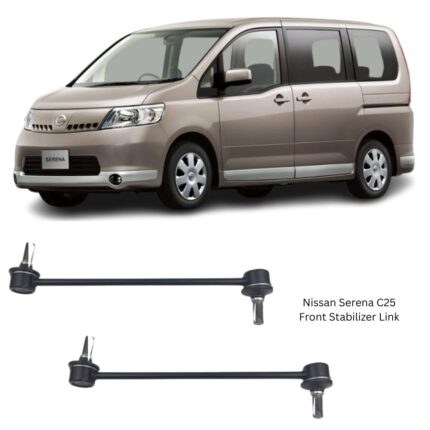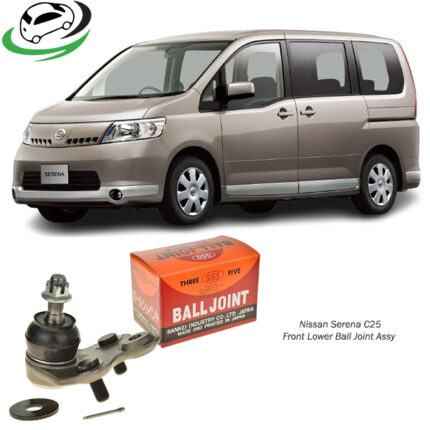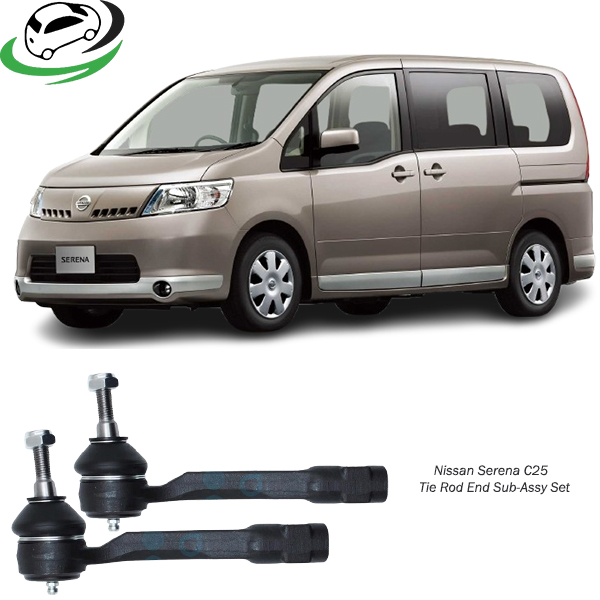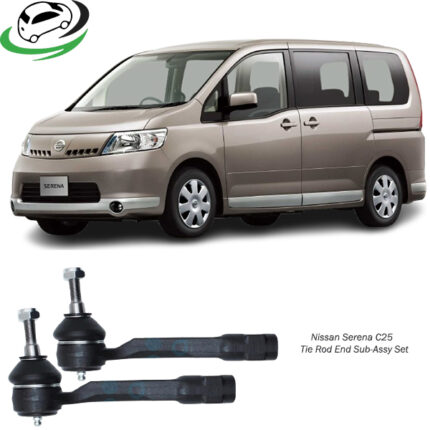Get Nissan Serena C25 Tie Rod End Sub-Assy Set SEN221 in Kenya
The tie rod end sub-assembly is a crucial component of a vehicle’s steering system, responsible for transmitting the movement of the steering rack to the wheels. This component allows the driver to control the vehicle’s direction by converting the rotational movement of the steering wheel into the left or right turning motion of the wheels. The tie rod end connects the steering linkage to the wheel, making it essential for safe and responsive handling.
In this article, we will explore the structure, function, types, maintenance, and signs of wear associated with tie rod ends. Understanding the role of this component can help ensure a properly functioning steering system, leading to better vehicle performance and safety.
1. Function and Importance of the Tie Rod End Sub-Assembly
The tie rod end is a part of the steering mechanism that connects the steering rack or steering box to the steering knuckle, which holds the wheels. When the driver turns the steering wheel, the steering rack moves, transferring this motion to the tie rods. The tie rods, in turn, cause the steering knuckles and wheels to pivot, steering the vehicle.
The tie rod end sub-assembly plays an essential role in ensuring that the wheels move in response to the driver’s commands. If a tie rod end is faulty or worn, it can cause a number of steering-related issues, such as difficulty steering, poor handling, and uneven tire wear. A properly functioning tie rod end is necessary to maintain accurate wheel alignment and ensure optimal handling.
2. Structure of the Tie Rod End Sub-Assembly
The tie rod end sub-assembly typically consists of several key components that allow it to function effectively. These components include:
- Ball Joint: The tie rod end contains a ball joint at its outermost end. This joint allows for pivoting and movement, enabling the steering knuckle to rotate as the wheels are turned. The ball joint is essential for accommodating the suspension’s range of motion while maintaining a secure connection between the steering components.
- Tie Rod: The tie rod is the long, slender rod that connects the inner tie rod to the outer tie rod end. The inner tie rod is connected to the steering rack or steering box, while the outer tie rod connects to the steering knuckle. The tie rod is often made of durable steel to withstand the forces exerted on it while driving.
- Dust Boot: The ball joint is typically protected by a rubber or synthetic dust boot, which keeps dirt, water, and debris from entering and damaging the joint. The dust boot also helps retain lubrication within the ball joint, preventing premature wear.
- Adjusting Nut: In some designs, the tie rod end includes an adjusting nut that allows for the adjustment of the tie rod length. This adjustment is often necessary to align the vehicle’s wheels properly, which ensures proper handling and reduces tire wear.
- Lock Nut or Cotter Pin: In some cases, a lock nut or cotter pin is used to secure the tie rod end in place, ensuring that it remains firmly connected to the steering knuckle or other steering components.
3. Types of Tie Rod Ends
There are several types of tie rod ends, and their specific design can vary depending on the vehicle’s steering system and application. The main types include:
- Outer Tie Rod End: The outer tie rod end connects the tie rod to the steering knuckle. It is located near the wheel and is responsible for controlling the turning motion of the wheels. The outer tie rod end typically contains the ball joint that allows for the movement of the steering knuckle.
- Inner Tie Rod End: The inner tie rod end connects the tie rod to the steering rack or steering box. It is located closer to the center of the vehicle and receives the movement from the steering rack. The inner tie rod end typically does not contain a ball joint but rather a threaded shaft that connects to the steering mechanism.
- Adjustable Tie Rod End: Some tie rod ends feature an adjustable design, allowing the mechanic to fine-tune the vehicle’s alignment. This adjustment can correct issues with wheel alignment, such as incorrect toe angles, ensuring that the vehicle handles correctly and that tire wear is minimized.
- Non-Adjustable Tie Rod End: Non-adjustable tie rod ends are typically found in vehicles with fixed steering systems. These are usually replaced as a complete unit when they wear out or are damaged, as they cannot be adjusted for alignment.
- Power Steering Tie Rod End: In vehicles equipped with power steering, the tie rod end may be designed to work in conjunction with the hydraulic or electric power steering system. These systems reduce the effort required by the driver to turn the steering wheel, making driving easier and more comfortable.
4. Symptoms of Wear or Failure in Tie Rod End Sub-Assemblies
The tie rod end sub-assembly is a durable part of the steering system, but over time, it can experience wear and tear due to the constant stress it undergoes. Worn or damaged tie rod ends can lead to a variety of symptoms that affect the steering performance of the vehicle. Common signs of wear or failure include:
- Loose or Unresponsive Steering: One of the most noticeable signs of a faulty tie rod end is a loose or unresponsive steering wheel. If the tie rod end is worn or damaged, there may be a delay or lack of precision when turning the steering wheel, making it harder to control the direction of the vehicle.
- Clunking or Popping Noises: A worn or loose tie rod end often produces a clunking or popping noise when the vehicle is turned, particularly when driving over bumps or uneven surfaces. This noise is typically caused by movement within the ball joint or the loose connection between the tie rod and steering knuckle.
- Vibrations in the Steering Wheel: If the tie rod end is excessively worn or the steering components are loose, the steering wheel may vibrate, particularly when driving at higher speeds. This can indicate that the alignment of the vehicle is off or that there is excessive play in the steering system.
- Uneven or Rapid Tire Wear: Worn tie rod ends can cause the wheels to be misaligned, which results in uneven or rapid tire wear. The vehicle may exhibit signs of toe misalignment, with one or both tires wearing down more quickly on the inside or outside edges.
- Steering Pulling: If the tie rod end is damaged or worn, it can cause the vehicle to pull to one side when driving. This is usually a result of improper alignment caused by the faulty tie rod end, and it can lead to difficulty steering in a straight line.
- Steering Wheel Off-Center: If the tie rod ends are not functioning properly, the steering wheel may appear off-center, meaning that the driver has to turn the wheel further in one direction to maintain a straight line. This misalignment can be caused by worn tie rod ends that are no longer keeping the wheels in the correct position.
5. Maintenance and Replacement of Tie Rod End Sub-Assemblies
Maintaining the tie rod end sub-assembly is essential for ensuring the proper function of the steering system and the safety of the vehicle. Regular inspection and timely replacement of worn or damaged tie rod ends can prevent further damage to other steering components, improve vehicle handling, and increase the lifespan of the tires. Here are some important maintenance and replacement tips:
- Regular Inspection: Regularly inspect the tie rod ends for any signs of wear, such as play or movement in the ball joints, cracks in the dust boot, or uneven tire wear. If you notice any of these signs, it may be time to replace the tie rod ends.
- Lubrication: Some tie rod ends are equipped with grease fittings that allow for lubrication. Regularly greasing the tie rod ends can reduce friction and prolong their lifespan, preventing premature wear on the ball joint.
- Alignment Checks: If you notice symptoms such as uneven tire wear or steering pulling, it is important to have the vehicle’s alignment checked. Misaligned tie rod ends can lead to poor handling and unsafe driving conditions, so it is essential to keep the wheels properly aligned.
- Replacement in Pairs: When replacing tie rod ends, it is often recommended to replace both the left and right sides simultaneously. This ensures that the steering system remains balanced, and the vehicle handles consistently.
- OEM Parts: Always use original equipment manufacturer (OEM) tie rod ends or high-quality aftermarket replacements to ensure a proper fit and long-term performance. OEM parts are designed to meet the vehicle’s specific requirements, ensuring the tie rod ends function as intended.
6. The Replacement Process
Replacing a tie rod end requires several steps and should typically be performed by a qualified mechanic. Here is a general overview of the replacement process:
- Lift the Vehicle: Raise the vehicle using a jack and secure it with jack stands. Remove the wheels to access the steering components.
- Remove the Tie Rod End: Using a wrench, loosen and remove the outer tie rod end from the steering knuckle. A special tie rod puller tool may be required to separate the tie rod end from the knuckle.
- Replace the Tie Rod End: Install the new tie rod end by threading it onto the steering rack or steering box. Ensure that the ball joint is securely connected to the steering knuckle.
- Reassemble the Steering System: Tighten the locking nuts or cotter pins to secure the tie rod end in place. Reassemble the steering components, making sure everything is properly aligned.
- Wheel Alignment: After replacing the tie rod ends, perform a wheel alignment to ensure the wheels are properly aligned and the vehicle handles correctly.
Conclusion
The tie rod end sub-assembly plays a vital role in the steering system by transferring steering input to the wheels and allowing for precise vehicle control. Regular maintenance and timely replacement of worn tie rod ends are essential for maintaining the vehicle’s handling and steering performance. By recognizing the symptoms of a failing tie rod end and addressing them promptly, vehicle owners can ensure their safety and prolong the lifespan of the vehicle’s steering components.
Follow us on Facebook for more parts.




